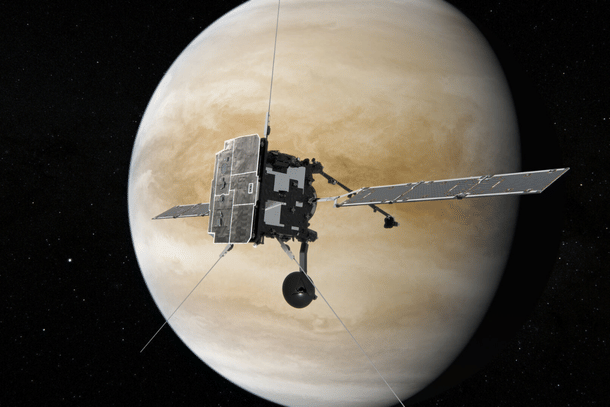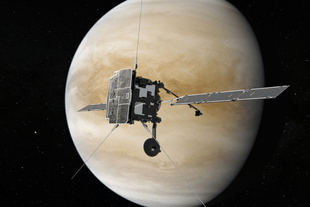Science
Double Venus Flyby: Two ESA Space Probes Swinging By Earth’s Twin Just 33 Hours Apart
Karan Kamble
Aug 09, 2021, 10:38 PM | Updated 10:45 PM IST
Save & read from anywhere!
Bookmark stories for easy access on any device or the Swarajya app.


Two European Space Agency (ESA) spacecraft are swinging by Venus today and tomorrow (9, 10 August) to complete a double Venus flyby just 33 hours apart.
The two missions, Solar Orbiter and BepiColombo, are using the gravitational pull of Venus to alter the speed and direction of the spacecraft, so that they are headed as planned towards their destinations. In the process, they will provide data that can help scientists better understand the Venus environment.
According to ESA, the double flyby will present “an unprecedented opportunity” to study the planet “from different locations at same time”. Among the plus points is that the spacecraft will go where a dedicated planetary orbiter typically wouldn’t.
ESA has a partnership with the National Aeronautics and Space Administration (NASA) for Solar Orbiter and with Japan Aerospace Exploration Agency for BepiColombo.
Solar Orbiter flyby complete
Solar Orbiter, tasked with taking images of the Sun from up close and making observations of its polar regions and solar wind, made a close pass of Venus earlier today.
The Orbiter’s closest approach to Venus, at 7,995 km, took place just after 10 am (Indian standard time) as the New Norcia tracking station in Australia followed its every move.
As expected, the station lost contact with the orbiter as it went around the back of the planet, but began to receive signals once again after a few minutes.
A few minutes ago, as the spacecraft swung behind the planet for its #VenusFlyby, New Norcia station lost contact w/ @ESASolarOrbiter as expected.
— ESA Operations (@esaoperations) August 9, 2021
We regain contact at about 06:48 CEST - the antenna at New Norcia is already pointed and waiting to reacquire signals!
This was Solar Orbiter’s second Venus flyby after it achieved its first in December last year. Now it is headed towards Earth for a gravity assist in November before it sails back towards Venus.
The repeated flybys around Earth and Venus will help in tilting the orbit, so that the Orbiter can get a good look at the Sun’s polar regions from multiple angles.
BepiColombo flyby on 10 August
BepiColombo, Europe’s first mission to Mercury, will follow suit tomorrow (10 August) for its Venus flyby. It will, however, fly a lot closer to the planet, at an altitude of 550 km.
Two cameras on the spacecraft will take black-and-white pictures in 1024 x 1024 resolution as it gets close, all the way until the planet goes out of sight days later.
The first image taken from the onboard camera is expected to be released tomorrow evening (10 August) while a bigger batch may become available the day after.
ESA mission to the Sun, Mercury
Solar Orbiter launched with the help of NASA in February last year aboard the Atlas V 411 rocket at Cape Canaveral, Florida. The spacecraft carries 10 instruments, some of which have been collecting data on the space environment around the Orbiter.
The first images were released in July and revealed “campfires”, or ever-present solar flares, near the surface of the Sun. In September, ESA released the first data for use by the scientific community and the wider public.
BepiColombo took off on a seven-year journey towards Mercury in October 2018. Its first Venus flyby occurred in October last year. It will need to complete nine gravity assist flybys around Earth, Venus, and Mercury before entering Mercury orbit around the planet in 2025.
The flybys, along with help from the solar electric propulsion system on board the spacecraft, will be necessary to enter Mercury orbit while resisting the strong gravitational pull of the Sun.
Mercury, after all, lies closest to the Sun. It is the smallest of all planets and happens to be the least-explored terrestrial planet in our solar system.
BepiColombo has a mission duration of one year around Mercury with a possible extension of one year. During that time, the Mercury Planetary Orbiter and the Mercury Magnetospheric Orbiter spacecraft will work together to collect and transmit important data back to Earth.
This data should be able to feed insights on the birth and evolution of a planet living close to its parent star.
Both Solar Orbiter and BepiColombo have one more flyby this year. Solar Orbiter will swing by Earth in late November to kick-start its main mission. BepiColombo, on the other hand, will go around Mercury for the first time in October.
The data emerging from these Venus flybys will be useful for ESA as it plans its Venus orbiter called EnVision, expected to launch in the 2030s.





